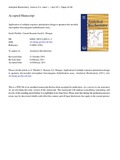- CERES Home
- →
- Cranfield Health
- →
- Staff publications - Cranfield Health
- →
- View Item
JavaScript is disabled for your browser. Some features of this site may not work without it.
| dc.contributor.author | Thiollet, Sarah | - |
| dc.contributor.author | Bessant, Conrad M. | - |
| dc.contributor.author | Morgan, Sarah L. | - |
| dc.date.accessioned | 2014-06-07T04:00:51Z | |
| dc.date.available | 2014-06-07T04:00:51Z | |
| dc.date.issued | 2011-07-01T00:00:00Z | - |
| dc.identifier.citation | Sarah Thiollet, Conrad Bessant, Sarah L. Morgan. Application of multiple response optimization design to quantum dot-encoded microsphere bioconjugates hybridization assay. Analytical Biochemistry, Volume 414, Issue 1, 1 July 2011, Pages 23–30. | |
| dc.identifier.issn | 0003-2697 | - |
| dc.identifier.uri | http://dx.doi.org/10.1016/j.ab.2011.02.024 | - |
| dc.identifier.uri | http://dspace.lib.cranfield.ac.uk/handle/1826/8521 | |
| dc.description.abstract | The optimization of DNA hybridization for genotyping assays is a complex experimental problem that depends on multiple factors such as assay formats, fluorescent probes, target sequence, experimental conditions, and data analysis. Quantum dot-doped particle bioconjugates have been previously described as fluorescent probes to identify single nucleotide polymorphisms even though this advanced fluorescent material has shown structural instability in aqueous environments. To achieve the optimization of DNA hybridization to quantum dot-doped particle bioconjugates in suspension while maximizing the stability of the probe materials, a nonsequential optimization approach was evaluated. The design of experiment with response surface methodology and multiple optimization response was used to maximize the recovery of fluorescent probe at the end of the assay simultaneously with the optimization of target-probe binding. Hybridization efficiency was evaluated by the attachment of fluorescent oligonucleotides to the fluorescent probe through continuous flow cytometry detection. Optimal conditions were predicted with the model and tested for the identification of single nucleotide polymorphisms. The design of experiment has been shown to significantly improve biochemistry and biotechnology optimization processes. Here we demonstrate the potential of this statistical approach to facilitate the optimization of experimental protocol that involves material science and molecular biology. | en_UK |
| dc.publisher | Elsevier Science B.V., Amsterdam | en_UK |
| dc.rights | NOTICE: this is the author’s version of a work that was accepted for publication in Analytical Biochemistry. Changes resulting from the publishing process, such as peer review, editing, corrections, structural formatting, and other quality control mechanisms may not be reflected in this document. Changes may have been made to this work since it was submitted for publication. A definitive version was subsequently published in Analytical Biochemistry, Volume 414, Issue 1, 1 July 2011, Pages 23–30. DOI:10.1016/j.ab.2011.02.024 | |
| dc.title | Application of multiple response optimization design to quantum dot-encoded microsphere bioconjugates hybridization assay | en_UK |
| dc.type | Article | - |
